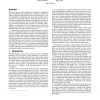Free Online Productivity Tools
i2Speak
i2Symbol
i2OCR
iTex2Img
iWeb2Print
iWeb2Shot
i2Type
iPdf2Split
iPdf2Merge
i2Bopomofo
i2Arabic
i2Style
i2Image
i2PDF
iLatex2Rtf
Sci2ools
EGH
2009
Springer
2009
Springer
Efficient ray traced soft shadows using multi-frusta tracing
Ray tracing has long been considered to be superior to rasterization because its ability to trace arbitrary rays, allowing it to simulate virtually any physical light transport effect by just tracing rays. Yet, to look plausible, extraordinary amounts of rays for effects such as soft shadows are typically required. This makes the prospects of real-time performance rather remote. Rasterization, in contrast, has a record of producing such effects in real-time through employing specialized and approximate solutions for individual effects. Though ray tracing may still be the right choice for effects like reflections and refractions, using specialized solutions for certain important effects also makes sense for a ray tracer. In this paper, we propose a special solution to ray trace soft shadows that is particularly targeted for Intel's Larrabee architecture. We use a specialized frustum tracing that traces multiple frusta of specialized "light-weight" shadow packets in paral...
| Added | 17 Feb 2011 |
| Updated | 17 Feb 2011 |
| Type | Journal |
| Year | 2009 |
| Where | EGH |
| Authors | Carsten Benthin, Ingo Wald |
Comments (0)

